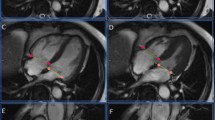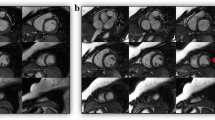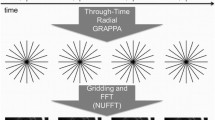Abstract
Cardiac MR is considered the gold standard in assessing RV function. The purpose of this study is to evaluate the clinical utility of an investigational iterative reconstruction algorithm in the quantitative assessment of RV function. This technique has the potential to improve the clinical utility of CMR in the evaluation of RV pathologies, particularly in patients with dyspnea, by shortening acquisition times without adversely influencing imaging performance. Segmented cine images were acquired on 9 healthy volunteers and 29 patients without documented RV pathologies using conventional GRAPPA acquisition with factor 2 acceleration (GRAPPA 2), a spatio-temporal TSENSE acquisition with factor 4 acceleration (TSENSE 4), and iteratively reconstructed Sparse SENSE acquisition with factor 4 acceleration (IS-SENSE 4). 14 subjects were re-analyzed and intraclass correlation coefficients (ICC) were calculated and Bland–Altman plots generated to assess agreement. Two independent reviewers qualitatively scored images. Comparison of acquisition techniques was performed using univariate analysis of variance (ANOVA). Differences in RV EF, BSA-indexed ESV (ESVi), BSA-indexed EDV (EDVi), and BSA-indexed SV (SVi) were shown to be statistically insignificant via ANOVA testing. R2 values for linear regression of TSENSE 4 and IS-SENSE 4 versus GRAPPA 2 were 0.34 and 0.72 for RV-EF, and 0.61 and 0.76 for RV-EDVi. ICC values for intraobserver and interobserver quantification yielded excellent agreement, and Bland–Altman plots assessing agreement were generated as well. Qualitative review yielded small, but statistically significant differences in image quality and noise between TSENSE 4 and IS-SENSE 4. All three techniques were rated nearly artifact free. Segmented imaging acquisitions with IS-SENSE reconstruction and an acceleration factor of 4 accurately and reliably quantitates RV systolic function parameters, while maintaining image quality. TSENSE-4 accelerated acquisitions showed poorer correlation to standard imaging, and inferior interobserver and intraobserver agreement. IS-SENSE has the potential to shorten cine acquisition times by 50 %, improving imaging options in patients with intermittent arrhythmias or difficulties with breath holding.



Similar content being viewed by others
References
Redington AN (2002) Right ventricular function. Cardiol Clin 20(3):341–349
Greyson CR (2008) Pathophysiology of right ventricular failure. Crit Care Med 36(1):S57–S65
Nieminen MS, Brutsaert D, Dickstein K, Drexler H, Follath F, Harjola VP, Hochadel M, Komajda M, Lassus J, Lopez-Sendon JL, Ponikowski P, Tavazzi L (2006) EuroHeart Failure Survey II (EHFS II): a survey on hospitalized acute heart failure patients: description of population. Eur Heart J 27:2725–2736
Joseph SM, Cedars AM, a Ewald G, Geltman EM, Mann DL (2009) Acute decompensated heart failure: contemporary medical management. Tex Heart Inst J 36(6):510–520
Kjaergaard J, Akkan D, Iversen KK, Køber L, Torp-Pedersen C, Hassager C (2007) Right ventricular dysfunction as an independent predictor of short- and long-term mortality in patients with heart failure. Eur J Hear Fail 9:610–616
Ghio S, a Gavazzi, Campana C, Inserra C, Klersy C, Sebastiani R, Arbustini E, Recusani F, Tavazzi L (2001) Independent and additive prognostic value of right ventricular systolic function and pulmonary artery pressure in patients with chronic heart failure. J Am Coll Cardiol 37(1):183–188
Vonk-Noordegraaf A, Souza R (2012) Cardiac magnetic resonance imaging: what can it add to our knowledge of the right ventricle in pulmonary arterial hypertension? Am J Cardiol 110(6 Suppl) 25S–31S
Winter MM, Bernink FJ, Groenink M, Bouma BJ, van Dijk AP, a Helbing W, Tijssen JG, Mulder BJ (2008) Evaluating the systemic right ventricle by CMR: the importance of consistent and reproducible delineation of the cavity. J Cardiovasc Magn Reson 10:40
Guo Y, Gao H, Zhang X, Wang Q, Yang Z, Ma E (2010) Accuracy and reproducibility of assessing right ventricular function with 64-section multi-detector row CT: comparison with magnetic resonance imaging. Int J Cardiol 139(3):254–262
Grothues F, Moon JC, Bellenger NG, Smith GS, Klein HU, Pennell DJ (2004) Interstudy reproducibility of right ventricular volumes, function, and mass with cardiovascular magnetic resonance. Am Heart J 147(2):218–223
Beygui F, Furber A, Delépine S, Helft G, Metzger J-P, Geslin P, Le Jeune JJ (2004) Routine breath-hold gradient echo MRI-derived right ventricular mass, volumes and function: accuracy, reproducibility and coherence study. Int J Cardiovasc Imaging 20(6):509–516
Sola S, White RD, Desai M (2006) MRI of the heart: promises fulfilled? Cleve Clin J Med 73(7):663–670
Carr JC, Simonetti O, Bundy J, Li D, Pereles S, Finn JP (2001) Cine MR angiography of the heart with segmented true fast imaging with steady-state precession. Radiology 219(3):828–834
Haase A (1990) Snapshot FLASH MRI. Applications to T1, T2, and Chemical-Shift Imaging. Magn Reson Med 13:77–89
Voit D, Zhang S, Unterberg-Buchwald C, Sohns JM, Lotz J, Frahm J (2013) Real-time cardiovascular magnetic resonance at 1.5 T using balanced SSFP and 40 ms resolution. J Cardiovasc Magn Reson 15(1):79
Kozerke S, Plein S (2008) Accelerated CMR using zonal, parallel and prior knowledge driven imaging methods. J Cardiovasc Magn Reson 10:29
a Guttman M, Kellman P, Dick AJ, Lederman RJ, McVeigh ER (2003) Real-time accelerated interactive MRI with adaptive TSENSE and UNFOLD. Magn Reson Med 50(2):315–321
Huang F, Akao J, Vijayakumar S, Duensing GR, Limkeman M (2005) k-t GRAPPA: a k-space implementation for dynamic MRI with high reduction factor. Magn Reson Med 54:1172–1184
Tsao J, Boesiger P, Pruessmann KP (2003) k-t BLAST and k-t SENSE: dynamic MRI with high frame rate exploiting spatiotemporal correlations. Magn Reson Med 50:1031–1042
Otazo R, Kim D, Axel L, Sodickson DK (2010) Combination of compressed sensing and parallel imaging for highly accelerated first-pass cardiac perfusion MRI. Magn Reson Med 64(3):767–776
Lustig M, Donoho D, Pauly JM (2007) Sparse MRI: the application of compressed sensing for rapid MR imaging. Magn Reson Med 58(6):1182–1195
Bilen C, Selesnick IW, Wang Y, Otazo R, Kim D, Axel L, Sodickson DK (2010) On compressed sensing in parallel mri of cardiac perfusion using temporal wavelet and tv regularization. In: Acoust. Speech Signal Process. (ICASSP), 2010 IEEE Int. Conf., pp 630–633
Allen BD, Carr M, Zenge MO, Schmidt M, Nadar MS, Spottiswoode BS, Collins JD, Carr JC (2014) Clinical evaluation of accelerated cardiac cine imaging using iterative k-t-sparse SENSE. J Cardiovasc Magn Reson 16(Suppl 1):W13
Clarke CJ, Gurka MJ, Norton PT, Kramer CM, Hoyer AW (2012) Assessment of the accuracy and reproducibility of RV volume measurements by CMR in congenital heart disease. JACC Cardiovasc Imaging 5(1):28–37
Liu J et al. (2012) Dynamic cardiac MRI reconstruction with weighted redundant Haar wavelets. In: Proc. 20th Annu. Meet. ISMRM, Melbourne, Australia, p 4249
Kellman P, Epstein FH, McVeigh ER (2001) Adaptive sensitivity encoding incorporating temporal filtering (TSENSE). Magn Reson Med 45(5):846–852
Marcus FI, McKenna WJ, Sherrill D, Basso C, Bauce B, Bluemke DA, Calkins H, Corrado D, MG Cox, Daubert JP, Fontaine G, Gear K, Hauer R, Nava A, Picard MH, Protonotarios N, Saffitz JE, DM Sanborn, Steinberg JS, Tandri H, Thiene G, Towbin JA, Tsatsopoulou A, Wichter T, Zareba W (2010) Diagnosis of arrhythmogenic right ventricular cardiomyopathy/dysplasia: proposed modification of the task force criteria. Circulation 121(13):1533–1541
Breitbart D, Robert F (2006) Tetralogy of fallot. In: Nadas’ pediatric cardiology, 2nd edn. Saunders, Philadelphia, pp 559–579
RWC Scherptong, a Mollema S, a Blom N, LJM Kroft, de Roos A, Vliegen HW, van der Wall EE, Bax JJ, Holman ER (2009) Right ventricular peak systolic longitudinal strain is a sensitive marker for right ventricular deterioration in adult patients with tetralogy of Fallot. Int J Cardiovasc Imaging 25(7):669–676
Geva T, Sandweiss BM, Gauvreau K, Lock JE, Powell AJ (2004) Factors associated with impaired clinical status in long-term survivors of tetralogy of Fallot repair evaluated by magnetic resonance imaging. J Am Coll Cardiol 43(6):1068–1074
SA Rebergen, Chin JG, Ottenkamp J, van der Wall EE, de Roos A (1993) Pulmonary regurgitation in the late postoperative follow-up of tetralogy of Fallot. Volumetric quantitation by nuclear magnetic resonance velocity mapping. Circulation 88(5):2257–2266
Oosterhof T, Tulevski II, Vliegen HW, Spijkerboer AM, BJ Mulder (2006) Effects of volume and/or pressure overload secondary to congenital heart disease (tetralogy of fallot or pulmonary stenosis) on right ventricular function using cardiovascular magnetic resonance and B-type natriuretic peptide levels. Am J Cardiol 97(7):1051–1055
Funding
Northwestern University Feinberg School of Medicine Area of Scholarly Concentration (AOSC) Summer Research Grant.
Author information
Authors and Affiliations
Corresponding author
Ethics declarations
Conflict of interest
Co-authors Spottiswoode, Zenge, Nadar, Zuehlsdorff, and Schmidt are Siemens employees.
Rights and permissions
About this article
Cite this article
Bogachkov, A., Ayache, J.B., Allen, B.D. et al. Right ventricular assessment at cardiac MRI: initial clinical experience utilizing an IS-SENSE reconstruction. Int J Cardiovasc Imaging 32, 1081–1091 (2016). https://doi.org/10.1007/s10554-016-0874-4
Received:
Accepted:
Published:
Issue Date:
DOI: https://doi.org/10.1007/s10554-016-0874-4




